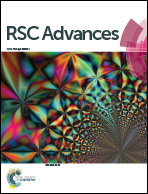DNA assembly of silicon quantum dots/gold nanoparticle nanocomposites†
Abstract
Silicon quantum dots (Si-QDs) dispersible in water and exhibiting bright near infrared (NIR) luminescence are a very attractive nano-light-emitter usable in bioimaging and biosensing. Here, we demonstrate the fabrication of NIR luminescent nanocomposites composed of Si-QDs and gold nanoparticles (Au-NPs) by DNA hybridization. We first develop processes to functionalize the surface of Si-QDs with different types of silane coupling agents without notably affecting the water solubility and the luminescence properties, and then conjugate the functionalized Si-QDs with single-stranded DNA (ssDNA). DNA hybridization with a Au-NP with complementary ssDNA results in the formation of Si-QDs/Au-NP nanocomposites.


 Please wait while we load your content...
Please wait while we load your content...